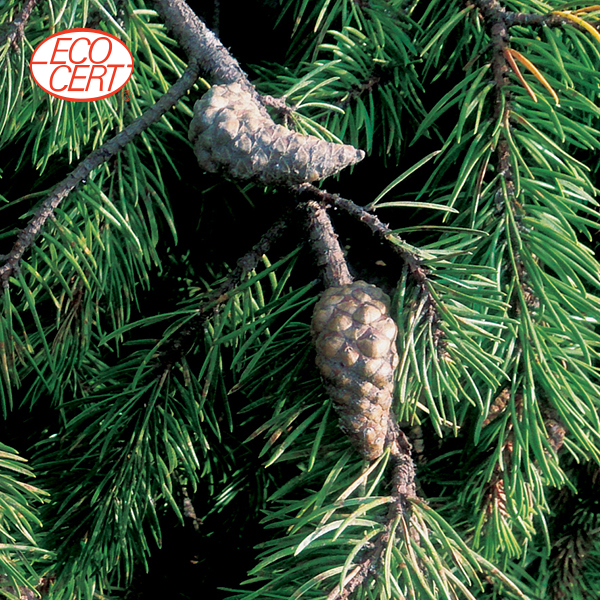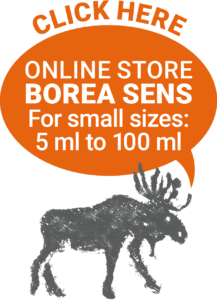JACK PINE ESSENTIAL OIL

Latin Name: Pinus banksiana
French Name: Pin Gris
English Name: Jack Pine
Family: Pinaceae
Origin: Quebec, Canada
Harvest time: May to October
Distilled Part: Twigs and Needles
Organoleptic Specificities: Pale yellow to greenish, woody and resinous smell.
Components: α-Pinene 45-60 %, β-Pinene 8-14 %, Bornyl acetate 4-10 %, δ3-Carene 4-10 %, Camphene 1-6 %
ORIGIN
This native tree, also called ‘cypress’ in Quebec, without belonging to this family, can reach up to 20 meters in height. It grows in the boreal forests of Canada, especially in the province of Quebec, Ontario and the prairies. Preferring poor and sandy soils, it can live up to 150 years. Its branches are often twisted, sometimes moribund or even dead looking, which can give it a neglected appearance. Its thin bark, reddish-brown to gray at the beginning of its life, matures to a dark brown, scaly hue with thick and irregular plates, interspersed with furrows.
The oblong cones scattered all along the branches measure 4-5 cm and can remain attached to the tree for a long time, from 10 to 15 years, so that lichen has time to develop there. Its seed production begins after the age of 30 and reaches its full potential around the age of 70-80. Seeds in cones can survive up to 25 years. Finally, its short needles are grouped in pairs and form a covering around its twigs and branches.
The Jack Pine’s survival strategy is particularly ingenious. The seeds of the female cones are held in place by its sap, which bursts open only under the effect of high heat. Thus, during a fire, the seeds can disperse over a distance of up to 100 meters and can germinate within a period of about ten days. As a result, the Jack Pine takes advantage of this mechanism to invade more territory and as it grows rapidly during the first 20 years of its life, it is well suited to spreading this way. Its survival is therefore directly related to forest fires, because in the absence of intense heat the seeds will remain dormant. In the past, pioneers despised this tree and tried to get rid of it by setting fire to it… naturally, they ended up with an abundance of Jack Pine!
This species is vital to the survival of the endangered Kirtland’s Warbler. Indeed, these small birds nest exclusively in the pure stands of young Jack Pines. In addition, porcupines feasts on the cambium of this tree.
HISTORY
Native Americans used Jack Pin resin to caulk canoes, as well as the seams on the roof of wigwams. The roots, on the other hand, were strong enough to be use to sew the bark of their canoes. The inside of the bark was made into a poultice to treat deep cuts. A fumigation of needles was used to wake up people who had fainted and to decongest the lungs.
BENEFITS
Jack Pine is largely composed of monoterpenes (C10), mainly α-Pinene and β-Pinene. This composition gives us a very compelling essential oil: a generally stimulating tonic for the body, and a very valuable anti-inflammatory for the respiratory and osteo-articular systems. It is also a very good stimulant for the digestive system, because of its exocrine-stimulating action at the level of digestive and intestinal glands. It also provides valuable aid in cases of respiratory infection.
PSYSICAL
- Circulatory System: lymphotonic.
- Skin System: anti-inflammatory at the initial stage, antibacterial, sedative, relaxing and soothing, lipophilic.
- Digestive System: aperitif, eupeptic, stomachic, antiparasitic, antifungal, tight solar plexus.
-
Endocrine System: corticomimetic with modulatory effect in the adrenals, also influences the autonomic nervous system with a targeted action on the smooth muscles of different organs.
-
Immune System: rapid and marked immunostimulant, airborne antiseptic, antibacterial, antiviral, antiparasitic, deworming, antifungal.
-
Respiratory System: Exocrino-stimulant (mucous glands of the lung), pulmonary decongestant thanks to its lymphotonic power, and a decongestant, thus allowing a deeper resolution than oxide 1.8 cineole, bronchitic syndrome, antioxidant, bronchial anti-inflammatory, cough suppressant and expectorant.
-
Nervous System: relaxing, calms acute pains, analgesic, anxiolytic.
-
Osteo-articular System: anti-inflammatory, analgesic, heating, stimulating, decongestant, anti- osteoarthritis (mimetic cortisone).
PSYCHIC
- Psychological toner
- Adaptogenic
- Stimulates the mind
- Promotes logical reasoning
- Increases the ability to concentrate
Uses: cold, bronchitis, sinusitis, catarrh, asthenia (tiredness), rheumatism, arthritis, immunosuppression, aerophagia, hot flash.
Contra-indications: to be avoided for the first three months of pregnancy, may cause redness if applied directly on the skin over the long term if the product is oxidized.
Recommendations: Essential oils are wonderful for the well-being of humans, animals, insects and plants. There are many books on the subject of aromatherapy and they should be referred to for the proper and safe use of essential oils. We also recommend that you consult an aromatherapy professional, who will be able to target the aromatic molecules of essential oils and their biochemical groupings, thereby increasing the effectiveness of your care.
It is recommended to store essential oils in a cool, dry place, away from light and air.
The information provided on this website is NOT a recommendation of a cure or the treatment of a medical condition or disease.
REfErences
-
Franchomme, P., Jollois, R,. Pénoël, D., L’aromathérapie exactement, Encyclopédie de l’utilisation thérapeutique des huiles essentielles : fondements, démonstration, illustration et applications d’une science médicale naturelle, Bayeux, Éditions Roger Jollois, 2001.
-
http://www.repertoirequebecnature.com/vasculaires/Pinusbanksiana.html
-
Moerman Daniel E., Native American Ethnobotany, Timber Press, Portland, Oregon, 1998.
-
a-Pinene isolated from Schinus terebinthifolius Raddi (Anacardiaceae) induces apoptosis and confers antimetastatic protection in a melanoma model
Alisson L. Matsuo a,⇑, Carlos R. Figueiredo a, Denise C. Arruda a, Felipe V. Pereira a, Jorge A. Borin Scutti a,
Mariana H. Massaoka a, Luiz R. Travassos a, Patricia Sartorelli b, João H.G. Lago b
a Disciplina de Biologia Celular, Departamento de Micro, Imuno e Parasitologia, Universidade Federal de São Paulo, Campus São Paulo, Brazil
b Instituto de Ciências Ambientais, Químicas e Farmacêuticas, Universidade Federal de São Paulo, Campus Diadema, Brazil -
Comparative Anti-Infectious Bronchitis Virus (IBV) Activity of (-)-Pinene: Effect on Nucleocapsid (N) Protein
Zhiwei Yang 1,2,†, Nan Wu 1,2,†, Yuangang Zu 1,2,* and Yujie Fu 1,2,*
1 Key Laboratory of Forest Plant Ecology, Ministry of Education, Northeast Forestry University, Harbin 150040, China
2 Engineering Research Center of Forest Bio-preparation, Ministry of Education, Northeast Forestry, University, Harbin 150040, China; E-Mails : yzws-123@163.com (Z.Y.); bao_doubao@yahoo.com.cn (N.W.); fuyujie1967@yahoo.com.cn (Y.J.F.)
† These two authors contributed equally to this work.
* Author to whom correspondence should be addressed; E-Mail : zygorl@vip.hl.cn
or fuyujie1967@yahoo.com.cn; Tel. : +86-451-82190535; Fax : +86-451-82190535. Received: 29 November 2010; in revised form: 23 December 2010 / Accepted: 17 January 2011 / Published: 25 January 2011 -
Intracerebral Distribution of α-Pinene and the Anxiolytic-like Effect in Mice Following Inhaled Administration of Essential Oil from Chamaecyparis obtusa
Hikaru Kasuya, Sayuka Iida, Kurumi Ono, Tadaaki Satou* and Kazuo Koike
Faculty of Pharmaceutical Sciences, Toho University, 2-2-1 Miyama, Funabashi, Chiba 274-8510, Japan
satou@phar.toho-u.ac.jp
Received: April 7th, 2015; Accepted : May 21st, 2015

